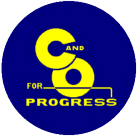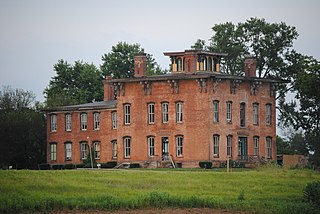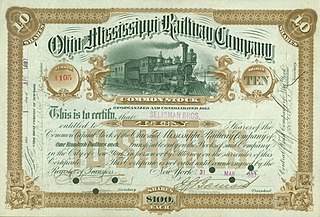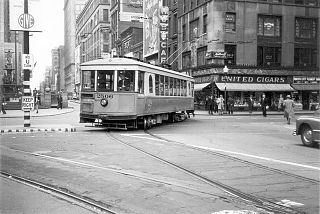The Little Miami Railroad was a railway of southwestern Ohio, running from the eastern side of Cincinnati to Springfield, Ohio. By merging with the Columbus and Xenia Railroad in 1853, it created the first through-rail route from the important manufacturing city of Cincinnati to the state capital, Columbus. In this period, railroads were important for creating connections between the important waterways of the Great Lakes and the Ohio River, which were major transportation routes for products to other markets.
The Cleveland, Cincinnati, Chicago and St. Louis Railway, also known as the Big Four Railroad and commonly abbreviated CCC&StL, was a railroad company in the Midwestern United States. It operated in affiliation with the New York Central system.

The Chesapeake and Ohio Railway was a Class I railroad formed in 1869 in Virginia from several smaller Virginia railroads begun in the 19th century. Led by industrialist Collis P. Huntington, it reached from Virginia's capital city of Richmond to the Ohio River by 1873, where the railroad town of Huntington, West Virginia, was named for him.

The Cincinnati, Lebanon and Northern Railway (CL&N) was a local passenger and freight-carrying railroad in the southwestern part of the U.S. state of Ohio, connecting Cincinnati to Dayton via Lebanon. It was built in the late 19th century to give the town of Lebanon and Warren County better transportation facilities. The railroad was locally known as the "Highland Route", since it followed the ridge between the Little and Great Miami rivers, and was the only line not affected by floods such as the Great Dayton Flood of 1913.
The Cincinnati, New Orleans and Texas Pacific Railway is a railroad that leases the Cincinnati Southern Railway from Cincinnati, Ohio, south to Chattanooga, Tennessee, and sub leases it to the Norfolk Southern Railway system.

The Cincinnati, Hamilton and Dayton Railway (CH&D) was a railroad based in the U.S. state of Ohio that existed between its incorporation on March 2, 1846, and its acquisition by the Baltimore and Ohio Railroad in December 1917. It was originally chartered to build from Cincinnati to Hamilton, Ohio, and then to Dayton, a distance of 59 mi (95 km); further construction and acquisition extended the railroad, and by 1902 it owned or controlled 640 mi (1,030 km) of railroad. Its stock and bond value plunged in late 1905 after "financial mismanagement of the properties" was revealed. The company was reorganized as the Toledo and Cincinnati Railroad in 1917.
The Pittsburgh, Fort Wayne and Chicago Railway was a major part of the Pennsylvania Railroad system, extending the PRR west from Pittsburgh, Pennsylvania, via Fort Wayne, Indiana, to Chicago, Illinois. It included the current Norfolk Southern-owned Fort Wayne Line east of Crestline, Ohio, to Pittsburgh, and the Fort Wayne Secondary, owned by CSX, from Crestline west to Tolleston in Gary, Indiana. CSX leased its entire portion in 2004 to the Chicago, Fort Wayne and Eastern Railroad (CFE). The remaining portion of the line from Tolleston into Chicago is now part of the Norfolk Southern's Chicago District, with a small portion of the original PFW&C trackage abandoned in favor of the parallel lines of former competitors which are now part of the modern NS system.

The Pittsburgh, Cincinnati, Chicago and St. Louis Railroad, commonly called the Pan Handle Route, was a railroad that was part of the Pennsylvania Railroad system. Its common name came from its main line, which began at Pittsburgh, Pennsylvania, crossed the Northern Panhandle of West Virginia, and continued west to Bradford, Ohio, where it split into a northern line to Chicago and a southern one through Indianapolis, Indiana, to East St. Louis, Illinois.

Trinway is an unincorporated community and census-designated place in northern Cass Township, Muskingum County, Ohio, United States, in the east-central part of the state. The village is 52 miles east of the state capital of Columbus and near the town of Dresden. Trinway is a rural community of mostly residential architecture.

Prospect Place, also known as The Trinway Mansion and Prospect Place Estate is a 29-room mansion built by abolitionist George Willison Adams in Trinway, Ohio, just north of Dresden in 1856. Today, it is the home of the non-profit G. W. Adams Educational Center, Inc. The mansion is listed on the National Register of Historic Places and the Ohio Underground Railroad Association's list of Underground Railroad sites.

The Cincinnatian was a named passenger train operated by the Baltimore and Ohio Railroad (B&O). The B&O inaugurated service on January 19, 1947, with service between Baltimore, Maryland and Cincinnati, Ohio, carrying the number 75 westbound and 76 eastbound, essentially a truncated route of the National Limited which operated between Jersey City, New Jersey and St. Louis.

The Ohio and Mississippi Railway, abbreviated O&M, was a railroad operating between Cincinnati, Ohio, and East St. Louis, Illinois, from 1857 to 1893.

Central Railroad Company of Indiana is a Class III short-line railroad that operates 92 miles (148 km) of track in Southeastern Indiana and Southwestern Ohio. CIND interchanges with CSX, Indiana & Ohio Railway, and Norfolk Southern in Cincinnati, Ohio, as well as North Bend, Ohio with CSX. It can hold up to 286,000 pounds of supplies.

The Indiana & Ohio Railway is an American railroad that operates 570 miles (920 km) of track in Ohio, southern Michigan, and parts of southeastern Indiana. It is owned and operated by Genesee & Wyoming, who acquired the railroad in the 2012 purchase of RailAmerica.
The Cincinnati Northern Railroad was a railroad that stretched from Franklin, Ohio, north to Jackson, Michigan, a distance of about 186 miles (299 km). It was acquired by the Cleveland, Cincinnati, Chicago and St. Louis Railway in 1901 and the New York Central Railroad several years later. Most of the line has since been abandoned.

The Cincinnati, Indianapolis and Western Railroad was established in 1915 as a reorganization of the Cincinnati, Indianapolis and Western Railway, which in turn had been created in 1902 as a merger of the Indiana, Decatur and Western Railway (ID&W) and the Cincinnati, Hamilton and Indianapolis Railroad (CH&I).

Streetcars operated by the Cincinnati Street Railway were the main form of public transportation in Cincinnati, Ohio, at the end of the 19th century and the start of the 20th century. The first electric streetcars began operation in 1889, and at its maximum, the streetcar system had 222 miles (357 km) of track and carried more than 100 million passengers per year. A very unusual feature of the system was that cars on some of its routes traveled via inclined railways to serve areas on hills near downtown. With the advent of inexpensive automobiles and improved roads, transit ridership declined in the 20th century and the streetcar system closed in 1951.












